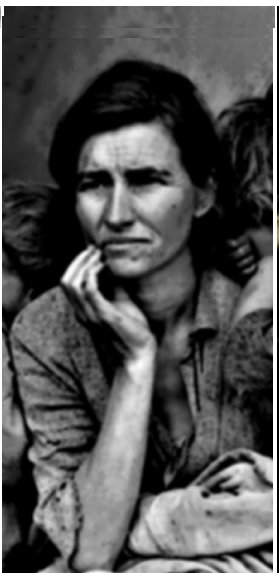
|Home| |Pre-American Settlement| |American Settlement--Civil War| |Late Nineteenth Century|
|Early Twentieth Century| |World War II and the Fifties| |Sixties--Present| |City Histories| |About|









 |
The Forgotten People of Spanish
Virginia M. Bouvier is a graduate
of Most history textbooks acknowledge
the great efforts of the Spanish explorers, conquistadores, and friars in
colonizing early Bouvier opens her books with the motivations behind Chapter
three discusses an important part of Spanish conquest¡Xevangelization. Catholic Spain
found it absolutely necessary to carry their religion into the In chapter five, Bouvier,
finished with discussing the three phases of Chapter seven describes a side of the conquest story that is exempt from most standardized textbooks¡Xthe resistance of the Indians. By studying different missionary and soldier logs, Bouvier discloses that many Native Americans did resist the missionization. Although there have been recorded instances of armed revolts, runaways, and open challenges to the priests¡¦ authority, most Indians understood that such bold actions would bring serious consequences. Instead, many natives resisted ¡§more often¡Kin much subtler forms, particularly within the realm of culture.¡¨9 They chose an easier form of resistance by doggedly holding on to their own spiritual beliefs, their language, and some of their daily habits and attitudes. In this way, the natives could resist without raising suspicion. Despite such records cultural resistance, the Franciscans ¡§frequently recoded indigenous activities in ways that would reflect positively on the mission enterprise.¡¨10 Dependent on the support of the Spanish Crown, the missionaries needed to display the success of the mission system. Recording indigenous resistance would show the Crown the failure of the mission project and would jeopardize the missionaries¡¦ efforts to convert and reteach the natives. Also, because the Franciscans believed in Spanish superiority, they were inclined to blame the natives, not the missionization, for such resistance against the system. Chapter eight consists of a brief recap of her purpose and the presentation of her final thoughts on women and their roles in Spanish California. She produces new citations that support her assertion of the need to study the women¡¦s experiences to complete history. Bouvier also admits that several things limited her research and her study, particularly the codes of silence which produced a partial record. In her book, Bouvier explores the
ways gender ideologies shaped and were transformed by Spanish conquest. She
asserts that gender notions were powerful factors in California¡¦s conquest,
holding together the colonization project and shaping both the Native
Americans¡¦ and the Spaniards¡¦ behaviors. Bouvier
places a great emphasis on women¡¦s roles in Spanish California¡¦s formation.
Seeking to go beyond merely acknowledging women presences, Bouvier
analyzes ¡§the meaning of their presence and the ways in which gender and race
ideologies might have affected their experiences and the relationship between
the cultures.¡¨11 She places a study of
male-female roles and relations, marriage, family, and sexuality in the context
of early myths and As an assistant professor of Latin American literature and
culture at the Robert M. Senkewiez, a professor of history at Santa Clara University, offers a critical review of Bouvier¡¦s book. He acknowledges her thesis¡¦s credibility and proceeds to applaud her achievements with the book. Senkewiez writes that Bouvier looked at history ¡§from the point of view of where the women were, who they were, and what they were doing.¡¨13 He refers to Bouvier¡¦s detail about the women¡¦s general conditions on the California frontier. Drawing from personal narratives, Bouvier presents facts about the Native Americans¡¦ daily lives before their conquest and during their time in missions such as clothing and diet before and after the missionization. Besides showing women¡¦s importance in California¡¦s history, Bouvier, according to Senkewiez, suggests ways in which women¡¦s inclusion in historical recordings ¡§can affect that shape the structure of the narratives themselves.¡¨14 In the book, several personal narratives show that women could drastically change situations. Senkewiez chooses to mention Eulalia Callis, who wrote that women could join the power struggle between the soldiers and the priests. Because of Bouvier¡¦s skillful portrayal of both the Hispanics¡¦ and the Native Americans¡¦ experiences, Senkewiez believes he has found a book that is an important contribution to California¡¦s history. Linda Pitelka, a member of the Department of History in the Maryville University of St. Louis, also provides a critical review of Bouvier¡¦s book. Like Senkewiez, Pitelka finds the book satisfying and commends Bouvier¡¦s achievements. She writes that the book ¡§underscores the complexities of race, ethnicity, and gender relations¡¨15 on the California frontier. Therefore, Bouvier achieved her intended purpose: analyzing the ways gender ideologies shaped Spanish California¡¦s development. Pitelka also mentions ¡§the most intriguing theme of [the] book¡KBouvier¡¦s depiction of multiple ¡¥codes of silence.¡¦¡¨16 Bouvier argues that the codes of silence were responsible for obscuring women¡¦s portrayal in early California¡¦s history. Therefore, throughout the novels, she reveals several codes of silence, such as the usually omitted information about female punishment at the missions and indigenous resistance. Pitelka commends Bouvier for going beyond the mere documentation of women¡¦s presence and illustrating ¡§the centrality of women and gender ideologies to and understanding of the history of the region.¡¨17 Instead of simply acknowledging the women¡¦s presence in early California, Bouvier analyzes server personal narratives to glean facts about the females¡¦ roles and the societal factor that shaped their behavior. Then, she applies these facts to the context of California¡¦s conquest and shows how important women were to the early frontier. According to Pitelka, ¡§this book may help scholars to think differently about the analysis of sources.¡¨18 Bouvier¡¦s findings about the codes of silence reveal a biased and fragmentary past and an obscured historical record. Her book serves to add new knowledge to history while raising significant questions for future exploration. In general, Bouvier writes a very insightful book. Spanish California¡¦s women are not commonly discussed for most children learn about the brave explorers, missionaries, and soldiers who formed a European civilization in the New World. However, Bouvier opens another point of view by focusing on ¡§how women¡¦s presence shaped conquest¡¨ and ¡§how conflicting gender ideologies provided a justification for conquest.¡¨19 She brings light to history¡¦s hidden corners and reveal the past¡¦s darker side. Her analysis allows people to learn about the different groups that made up the Spanish conquest, especially the forgotten ones such as women and the Native Americans. She also reveals several codes of silence that portray a pessimistic view of the missions and its leaders and that have been obscuring the historical records for years. However, Bouvier relies too strongly on quotations. Although these quotations greatly help the thesis, almost every sentence is broken by an excerpt, interrupting the flow of words. Despite this flaw, Bouvier¡¦s book provides useful knowledge about California¡¦s conquest. As the mother country, Spain played an important role in California¡¦s conquest. Despite the great distance between California and Spain, ¡§supreme authority rested with the [Spanish] Crown.¡¨20 All explorers and missionaries were sponsored by the Spanish royalty. Therefore, these men were subject to the demands of the Crown on how to conquer and control California. Also, the myths and the stories that formed in Spain formed the social beliefs that would determine the Spaniards¡¦ behaviors towards the indigenous people. California¡¦s ¡§fictional representation as pagan¡Kfemale¡Kand easily subdued¡¨ reinforced the conquerors¡¦ imagined superiority. 21 Early stories about California molded the Spanish people into strongly believing in their own superiority. This led to a motivation for conquest¡Xsince the Spanish were the superior race, it was their job to teach the natives. This belief also provided the context for the Hispanicization that occurred in the missions. Proclaiming the ¡§absolute superiority of Spanish Catholic civilization,¡¨ the Franciscans argued in favor of ¡§imposing Hispanic Catholic values¡¨ on the indigenous population.22 Biased against the indigenous culture, the Franciscans sought to covert the Native Americans to both Christianity and the Spanish culture. In their eyes, the indigenous culture, so different from the Hispanic culture, was wrong and needed to be eliminated. During the Spanish conquest, California reflected the events and the beliefs of Spain. Spain amassed a vast territory in the Americas during its
golden years, but compared to the Mexico territories and even Baja California,
Alta California was slightly unique. Because of its location, California¡¦s
¡§relatively late discovery¡Kensured that the Spanish conquest¡Kwould follow a different
path.¡¨23 By the time explorers reached
California, the encomienda system had proven to be a
failure. The system¡¦s abusive nature and the encomienda
leaders¡¦ growing power caused the Crown to abolish the system, ensuring that
California would be settled differently than the rest of New Spain. Also, Alta
California, with its diverse groups of indigenous populations, was ¡§purported
to be the most densely settled land in all of northern New Spain.¡¨24
In Alta California, the Spanish had to subjugate a much more diverse population
that anywhere else in the Americas. Therefore, the missionaries and the
soldiers had to face harder obstacles for many barriers such as language and
culture had to be broken. Also, unlike Baja California¡¦s Jesuit missions, Alta
California¡¦s Franciscan missions ¡§were founded at a time of relative decline of
church influence [over] the state.¡¨25
Therefore, the Franciscan missions¡¦ organization was distinct from the Jesuit
missions¡¦. Unlike Jesuit missions¡¦ head priest, the Franciscan missions¡¦
leading friar did not control all aspects of the missions. Therefore, the
hierarchy in the Franciscan missions led to tensions between the Spanish
soldiers and the missionaries for each groups¡¦ power status was not clearly
defined. In many ways, Alta California developed much differently from the
previous Spanish colonies. Through many sources, Bouvier connects a suppressed history¡¦s fragments to present California missionization¡¦s hidden side. However, her book is not just about Spanish California¡¦s women. Rather, Bouvier uses the women¡¦s experiences to portray how the different gender ideologies that shaped and influenced California¡¦s conquest and the individual people. However, Bouvier admits that her study is ¡§far from¡Kdefinitive¡¨ for it is ¡§limited by the partial nature of data about women, by multiple codes of silence about female experiences, sexuality, ceremonies, and the use of force, and by the tremendous diversity of the indigenous groups in Alta California.¡¨26 1. Bouvier, Virginia M. Introduction.
Introduction. By Bouvier. 2. Bouvier, Virginia M. Women
and the Conquest of 3. Bouvier, Virginia M. 29. 4. Bouvier, Virginia M. 34. 5. Bouvier, Virginia M. 55. 6. Bouvier, Virginia M. 58 7. Bouvier, Viginia
M. 105. 8. Bouvier, Virginia M. 107. 9. Bouvier, Virginia M. 149. 10. Bouvier, Virginia M. 168. 11. Bouvier, Virginia M.
Introduction. Introduction. By Bouvier. 12. Bouvier, Virginia M.
Introduction. Introduction. By Bouvier. 13. Senkewiez, Robert M. ¡§Women and
the Conquest of 14. Senkewiez, Robert M. 15. Pitelka, Linda. ¡§Review of
Virginia M. Bouvier, Women and the Conquest of 16. Pitelka, Linda. 17. Pitelka, Linda. 18. Pitelka, Linda. 19. Bouvier, Virginia M. 174. 20. Bouvier, Virginia M. 35. 21. Bouvier, Virginia M. 5. 22. Bouvier, Virginia M. 108. 23. Bouvier, Virginia M. 4. 24. Bouvier, Virginia M. 19. 25. Bouvier, Virginia M. 35. 26. Bouvier, Virginia M. 174. |